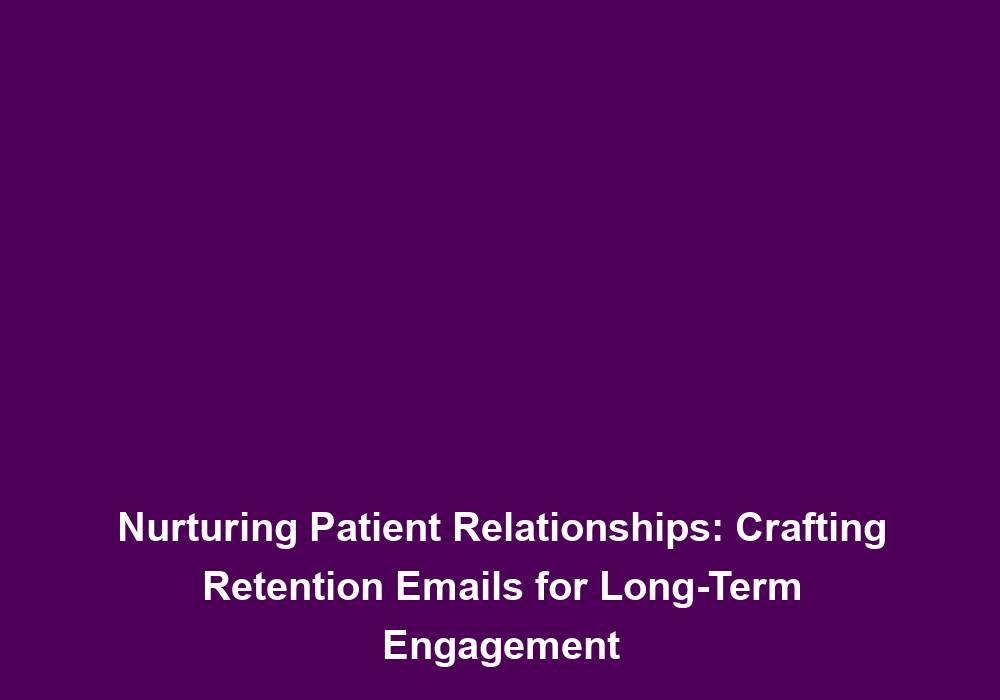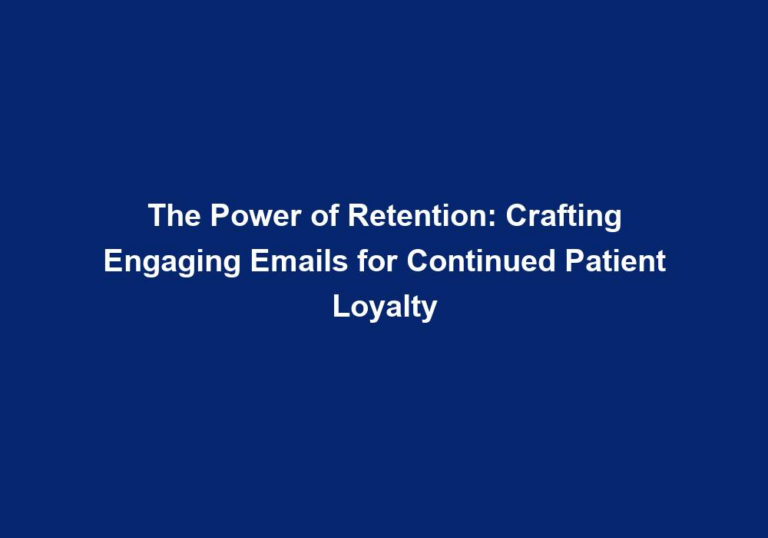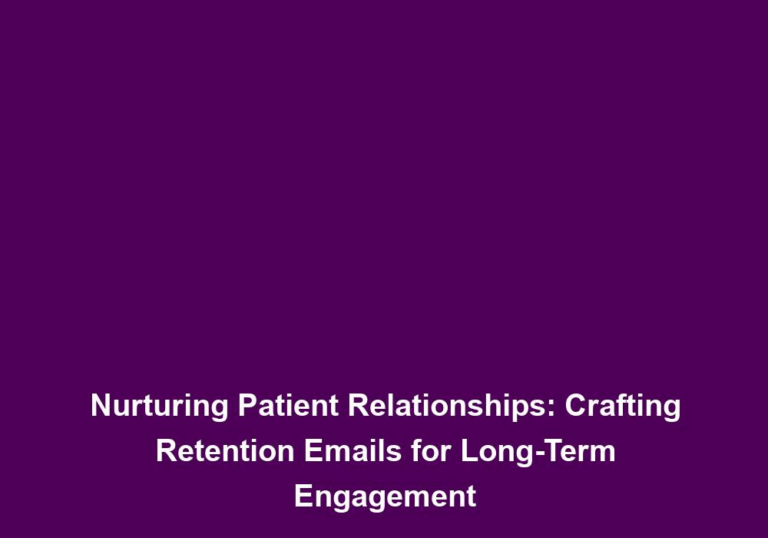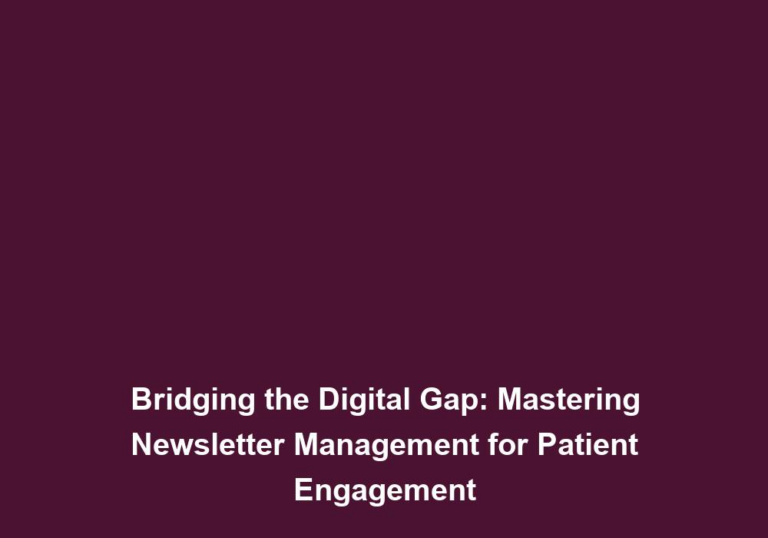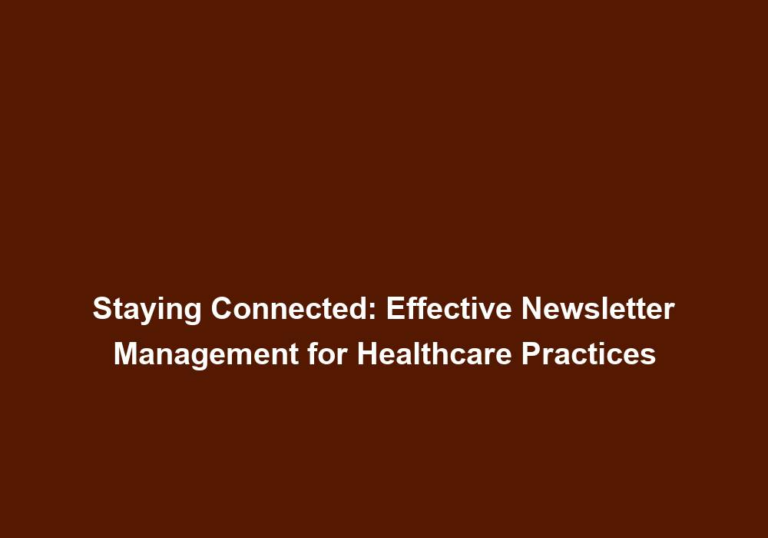Nurturing Patient Relationships: Crafting Retention Emails for Long-Term Engagement
In the healthcare industry, building strong and lasting relationships with patients is crucial for long-term success. Retaining patients and keeping them engaged in their healthcare journey is a challenging yet essential task. One effective way to achieve this is through well-crafted retention emails.
Retention emails play a vital role in nurturing patient relationships as they provide an opportunity to connect, communicate, and engage with patients on a regular basis. These emails can help healthcare providers stay top-of-mind, build trust, and encourage patients to actively participate in their own healthcare management. In this article, we will explore the key elements and strategies to create compelling retention emails that foster long-term patient engagement.
Understanding the Target Audience
Before diving into the creation of retention emails, it’s important to have a clear understanding of your target audience. Different patient segments may require tailored approaches to ensure maximum effectiveness. Consider demographics, age groups, health conditions, and individual preferences when crafting your email content.
Paragraph 1: When understanding the target audience for your retention emails, it’s crucial to consider their demographics. Factors such as age, gender, location, and occupation can greatly influence the type of content that resonates with them. For example, if you’re targeting an older demographic, you may want to focus on health conditions that are more prevalent in that age group, such as arthritis or diabetes. On the other hand, if your target audience is predominantly young adults, you might want to emphasize preventive measures and lifestyle choices that promote overall wellness.
Paragraph 2: In addition to demographics, it’s important to consider the specific health conditions of your target audience. Tailoring your email content to address their unique needs and challenges can greatly enhance the effectiveness of your retention emails. For instance, if you’re targeting patients with asthma, you can provide information on asthma triggers, tips for managing symptoms, and updates on new treatment options. By addressing their specific health concerns, you demonstrate that you understand their individual needs and are committed to supporting their healthcare journey.
Paragraph 3: Lastly, take into account the preferences of your target audience when crafting your retention emails. Some patients may prefer to receive concise and actionable information, while others may appreciate more detailed and educational content. You can gather this information through patient surveys, feedback forms, or by analyzing their previous interactions with your healthcare facility. By delivering content in the format and style that resonates with your audience, you increase the likelihood of engagement and long-term retention.
Personalization and Relevancy
One of the most significant aspects of crafting effective retention emails is personalization. Patients appreciate receiving content that is relevant to their specific needs and interests. By leveraging patient data, such as previous appointments, healthcare history, or preferences, you can personalize the content and make it more engaging.
Paragraph 1: Addressing the patient by their name in the email subject and body is a simple yet effective way to personalize your retention emails. It creates a sense of familiarity and shows that you value them as an individual. Additionally, acknowledging their recent interactions with your healthcare facility, such as previous appointments or inquiries, helps to establish a personal connection and demonstrates that you’re attentive to their needs.
Paragraph 2: Another way to personalize your retention emails is by recommending relevant health resources or articles based on the patient’s specific conditions or interests. For example, if a patient has recently been diagnosed with hypertension, you can provide them with information on healthy eating habits, exercise routines, and stress management techniques that are beneficial for managing their condition. This personalized approach shows that you understand their unique healthcare goals and are committed to supporting their well-being.
Paragraph 3: Tailoring the email content based on the patient’s specific healthcare goals is another effective way to personalize your retention emails. For instance, if a patient has expressed an interest in weight management, you can provide them with resources, tips, and encouragement to help them achieve their goals. By aligning your content with their individual aspirations, you demonstrate your commitment to their overall health and empower them to take an active role in their healthcare management.
Engaging Subject Lines
The subject line of your retention email is the first impression that patients have of your communication. It must capture their attention, create curiosity, and entice them to open the email. A well-crafted subject line can significantly impact the open rates of your emails. Consider the following tips:
Paragraph 1: Keep your subject lines concise and to the point. Patients are more likely to open an email if they can quickly understand what it’s about and how it’s relevant to them. Avoid lengthy subject lines that may get cut off or lose their impact in crowded inboxes.
Paragraph 2: Use action-oriented language to create a sense of urgency and excitement. Words like “Discover,” “Learn,” or “Exclusive” can pique the interest of patients and make them curious to explore what’s inside the email. However, ensure that the content of the email lives up to the promise made in the subject line to maintain trust and engagement.
Paragraph 3: Incorporate personalization elements into your subject lines to make them more compelling. Including the patient’s name or mentioning their specific healthcare needs or interests can grab their attention and make them feel that the email is tailored to their individual needs. For example, a subject line like “John, discover the latest advancements in managing diabetes” is likely to resonate more with a diabetic patient named John compared to a generic subject line like “Stay informed about diabetes management.”
Compelling Email Content
Once you have successfully captured the attention of your patients with an engaging subject line, it’s important to deliver valuable and compelling content. Here are some key points to consider while creating your email content:
-
Educational Information: Provide useful and relevant information that educates patients about their health conditions, preventive measures, or updates in the healthcare industry. This helps position your healthcare facility as a trusted source of knowledge and expertise. Include statistics, research findings, and practical tips that empower patients to make informed decisions about their health.
-
Appointment Reminders and Follow-ups: Send reminders for upcoming appointments and follow-up emails after visits. This shows your commitment to patient care and helps patients stay organized with their healthcare schedules. Include important details such as the date, time, and location of the appointment, as well as any specific instructions or preparations they need to be aware of.
-
Wellness Tips and Advice: Share practical tips and advice for maintaining overall wellness. This could range from exercise routines, healthy eating habits, stress management techniques, or recommended screenings. Include step-by-step instructions, visuals, and links to additional resources that patients can explore for more in-depth information.
-
Patient Testimonials and Success Stories: Include patient testimonials and success stories that highlight the positive impact of your healthcare services. These stories can inspire and motivate patients to actively engage in their own healthcare journeys. Include before-and-after photos, quotes from satisfied patients, and specific details about the improvements they experienced as a result of your services.
-
Healthcare Events and Community Engagements: Inform patients about healthcare events, workshops, or community engagements happening in your facility or local area. Encouraging patients to participate fosters a sense of community and enhances their overall experience. Include details such as the date, time, location, and any registration or participation requirements. Highlight the benefits of attending these events, such as opportunities for learning, networking, and receiving personalized healthcare advice.
Call-to-Action and Feedback
To foster further engagement, provide clear and actionable next steps for patients. Include a prominent call-to-action (CTA) that encourages them to take specific actions, such as scheduling an appointment, signing up for a newsletter, or participating in a survey. CTAs help guide patients towards further interactions and allow you to track and measure the success of your email campaigns.
Additionally, invite patients to provide feedback on their experiences with your healthcare facility. Listening to patients’ opinions and suggestions not only helps improve your services but also strengthens the patient-provider relationship. Consider including a link to a feedback form or a dedicated email address for patients to reach out to you directly.
Measuring and Optimizing
To ensure the effectiveness of your retention emails, it’s important to measure their performance and continuously optimize your strategies. Keep track of key metrics such as open rates, click-through rates, and conversions. Analyze the data regularly to identify areas for improvement and test different elements, such as subject lines, content formats, or CTAs.
By consistently monitoring and optimizing your retention emails, you can enhance patient engagement, strengthen relationships, and ultimately boost patient retention rates.
Conclusion
Crafting well-designed and personalized retention emails is a powerful tool for nurturing patient relationships and fostering long-term engagement. By understanding your target audience, personalizing content, using engaging subject lines, delivering valuable information, and including clear CTAs, you can create compelling emails that keep patients connected and actively involved in their healthcare journey.
Remember, strong patient relationships are built on trust, excellent communication, and consistently providing value. Invest time and effort in crafting retention emails that reflect these principles, and you will see the positive impact on patient engagement and loyalty.

